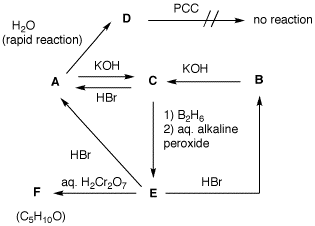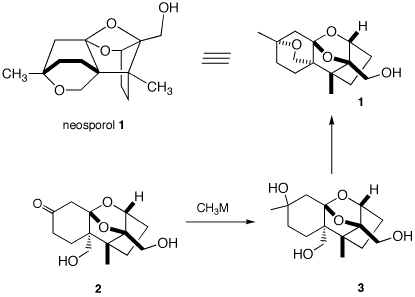The alcohol module in ORGO
will give you a good review of some of the fundamental
reactions discussed in class and in Chapters 8 and 9. As
you master the chemistry of alcohols, you should try the
Web
of Reactions. 1. How many grams of KMnO4
in aqueous KOH are required to oxidize 20 grams of
1,2-cyclohexanediol to adipic acid? [Note:
MnO2 is the reduction propuct of permanganate.
This is a redox reaction from Gen. Chem. Go
here for help. Derive the
balanced equation and show your work.]. MnO4-
---> MnO2 then add two oxygens
on the right by using two hydroxyls and one water for
each oxygen. 2H2O +
MnO4- ---> MnO2 + 4HO
- (+ 3-electrons; eq. 1) Now, C6H12O2
--->
C6H10O4 requires two oxygen on
the left and two hydrogens on the right. First, the
oxygen: 4HO - +
C6H12O2 --->
C6H10O4 +
2H2O Now the
hydrogens: 2HO - + 4HO
- + C6H12O2
---> C6H10O4 +
2H2O +
2H2O This equation
simplifies to 6HO - +
C6H12O2 --->
C6H10O4 +
4H2O (- 6-electrons; eq. 2) Multiplying eq. 1 by a
factor of two to balance the electrons gained and lost,
we have 4H2O +
2MnO4- ---> 2MnO2 +
8HO - (+ 6-electrons; eq. 3) Adding eqs. 2 and 3,
we have 6HO - +
C6H12O2 +
4H2O + 2MnO4- --->
C6H10O4 +
4H2O + 2MnO2 + 8HO
- Simplifying
yields C6H12O2
+ 2MnO4- --->
C6H10O4 +
MnO2 + 2HO - (eq. 4) ------------------------------------- KMnO4 MW. =
154; C6H12O2 MW =
116 Thus, 2 x 154/116 =
x/20; x = 54.5 g KMnO4 Victor Grignard
(1871-1935) 2. Optically-active compound A
(C10H20O2) reacts with
LiAlH4 in ether to form a single
optically-inactive compound B
(C5H12O). Bromide C is
converted into its Grignard reagent D. Reagent
D reacts with A to form optically-active
E (C9H20O) and
(S)-B. What are the structures A-E?
Explain and illustrate. 3. Predict the products and/or
reagents in each of the following examples. Justify your
answers. 4. Two bottles on a shelf have had
their labels fall off. Both of the labels read
"C5H11Br". A student decides to run
some reactions on the contents of bottle A and
B to determine the structures of the two
compounds. From the flow chart determine the structure of
A and B and identify C-F. Show your
reasoning. [Hint: Draw all of the structures
of C5H11Br. Eliminate
non-contenders?] 5. Neosporol (1), which is
shown in two views, was successfully synthesized from
racemic ketone 2, whose synthesis is well beyond
the scope of this question. The immediate problem was to
convert ketodiol 2 into triol 3. [The
fact-oid-s have been altered slighted to facilitate the
question. (J.
Am. Chem. Soc., 1993, 115,
2581) ] When an excess of
methyllithium was used to convert the ketone function of
2 into the tertiary alcohol of 3, only
ketodiol 2 was recovered upon aqueous workup. A
Jmol structure of neosporol is provided. Move the
structure around to compare it with the two views of
neosporol 1. a) What is the minimum amount of
methyllithium required in this reaction?
Explain? b) What events occurred prior to
aqueous work up? [Hint: Generally, organolithium and
Grignard reagents undergo addition but they are also the
conjugate bases of weak acids.] What was the fate of
the ketone group? When methyl magnesium bromide was
employed, both 2 and a mixture of the
diastereomers of 3 were obtained. Complete
conversion of 2 to 3 (5/1 mixture of
diastereomeric tertiary alcohols) was effected cleanly
with the cerium reagent,
CH3CeCl2. c) Draw the structures of the two
diastereomers of 3, i.e., provide stereochemistry
in structure 3.] d) Provide conditions and a mechanism
for the conversion of 3 to 1. Is it
necessary to separate the diastereomers of 3 prior
to forming 1?
First,



Neosporol